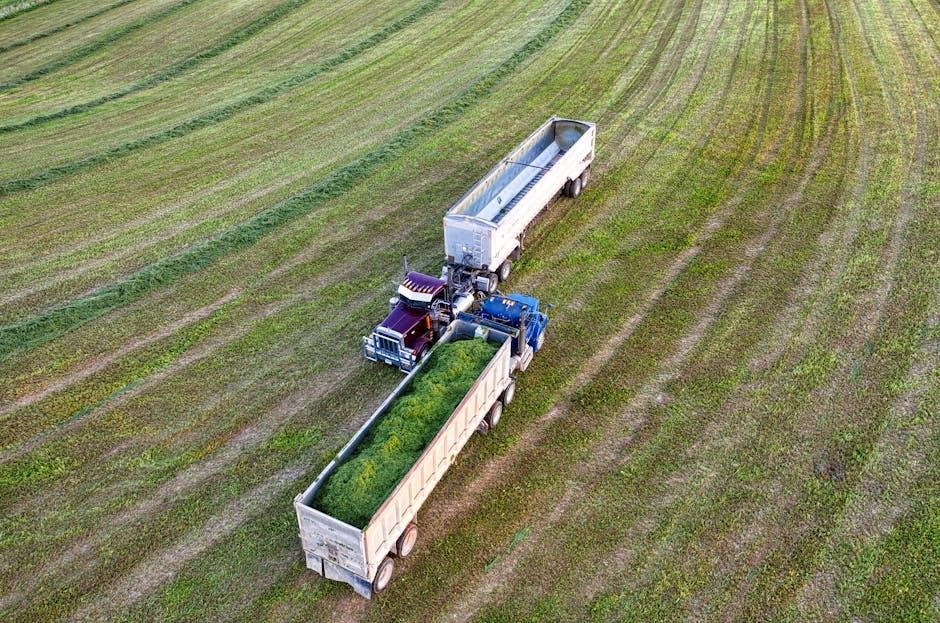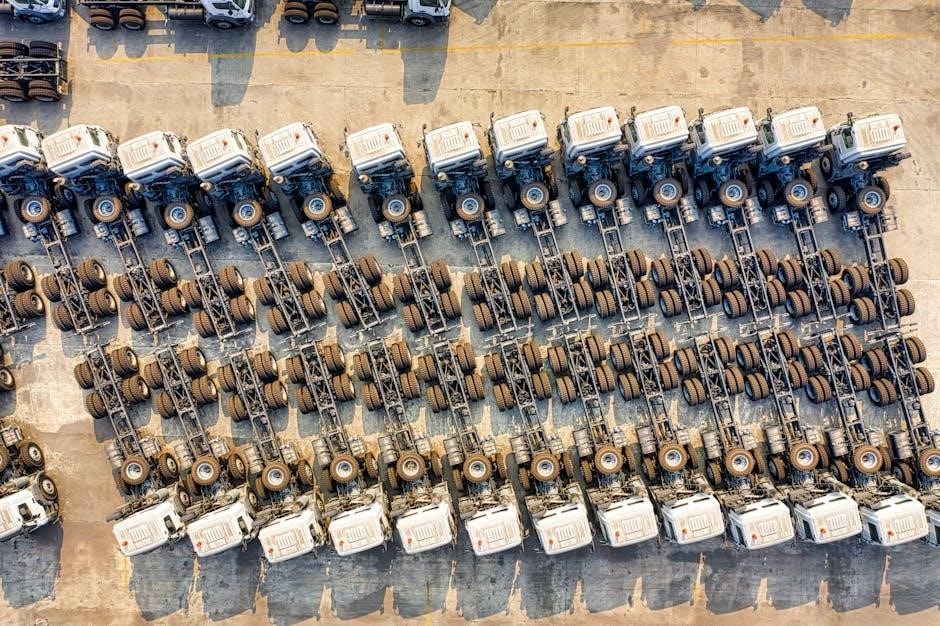are all semi trucks manual
Not all semi-trucks are manual, as the industry shifts toward automatic and automated manual transmissions. While manual transmissions were once standard, offering control and durability, automatics now dominate, enhancing ease of use and reducing driver fatigue.

What Are Semi-Truck Transmissions?

Semi-truck transmissions are complex systems responsible for transferring power from the engine to the wheels through a series of gears and shafts. The driver selects gears manually or automatically to optimize performance based on speed and load. These transmissions are designed to handle the heavy demands of hauling large loads over long distances.
Manual transmissions have traditionally been the norm, offering drivers precise control and durability; They feature multiple gears, including low, intermediate, and high ranges, allowing for better power management in varying conditions. However, manual transmissions require significant skill and can lead to driver fatigue during long hauls.
Automatic transmissions, on the other hand, are gaining popularity due to their ease of use and reduced driver fatigue. Modern automatics are designed to handle heavy torque and are increasingly favored by fleets and newer drivers. Additionally, automated manual transmissions (AMTs) blend elements of both, using a manual gearbox with computer-controlled shifting for improved efficiency.
These systems are essential for efficient operation, enabling semi-trucks to navigate diverse terrains and conditions effectively. The evolution of transmission technology reflects the industry’s shift toward balancing performance, ease of use, and efficiency.
Why Transmission Type Matters
The type of transmission in a semi-truck plays a crucial role in its performance, efficiency, and driver experience. Manual transmissions, traditionally the standard, offer precise control and durability but demand significant skill and can lead to driver fatigue. Automatic transmissions, increasingly popular, reduce fatigue and are easier to operate, making them ideal for newer drivers and fleets facing a driver shortage.
Transmission choice also impacts fuel efficiency, maintenance costs, and overall productivity. Modern automatics now rival manuals in efficiency, while manuals may offer cost savings in repair. Additionally, automated manual transmissions (AMTs) provide a balance, combining manual gearing with automatic shifting for optimal performance in varying conditions.
With the trucking industry evolving, transmission type influences both individual driver preference and fleet operations. The shift toward automatics reflects broader trends like technological advancement and the need for ease of use. Ultimately, the right transmission ensures smoother operations, better fuel economy, and reduced wear on both the vehicle and the driver.
Types of Semi-Truck Transmissions
Semi-truck transmissions are categorized into three main types: manual, automatic, and automated manual. Manual transmissions require driver interaction for gear shifting, while automatics handle shifting automatically. Automated manuals combine manual gears with automatic clutch control, offering a balance between efficiency and driver input.
Manual Transmissions

Manual transmissions in semi-trucks are traditional systems requiring drivers to engage gears using a clutch pedal and shift lever. These transmissions typically feature 10 to 18 gears, enabling precise control over power delivery, especially in varying terrains. Experienced drivers often prefer manuals for the control and efficiency they offer. However, they demand higher skill levels and can contribute to driver fatigue during long hauls. Despite their popularity among seasoned operators, manual transmissions are gradually being phased out in favor of automatic and automated manual transmissions, which are easier to operate and reduce fatigue; The shift reflects industry trends toward efficiency, driver comfort, and addressing the challenges of a shrinking pool of skilled manual transmission drivers.
Automatic Transmissions
Automatic transmissions in semi-trucks have gained significant popularity due to their ease of operation and reduced driver fatigue. Unlike manual transmissions, automatics eliminate the need for manual gear shifting, allowing drivers to focus more on the road. Modern automatic transmissions are equipped with advanced technology, offering smoother acceleration and improved fuel efficiency. They are particularly beneficial for newer drivers or those who prefer a less physically demanding experience. Many fleets are transitioning to automatics because they simplify training and attract a broader range of drivers. With the ability to handle heavy loads and torque efficiently, automatic transmissions are now the preferred choice for 90% of new semi-trucks produced. Their ease of use, combined with advancements in performance, has made them a cornerstone of the trucking industry’s shift toward modernization and efficiency.
Automated Manual Transmissions
Automated Manual Transmissions (AMTs) represent a hybrid approach, combining elements of both manual and automatic transmissions. These systems use a manual gearbox but employ computerized controls to automatically shift gears, eliminating the need for a clutch pedal. AMTs are designed to offer the fuel efficiency and driver control of manual transmissions while reducing the complexity and physical demands of shifting. They are particularly popular among fleets and experienced drivers who value the familiar feel of manual shifting but appreciate the convenience of automation. AMTs are seen as a compromise between traditional manuals and fully automatic transmissions, providing a bridge for drivers transitioning to newer technologies. With advancements in technology, AMTs have become more refined, offering smoother shifting and improved performance. They are widely regarded as a practical solution for modern trucking needs, balancing efficiency, control, and ease of use. As the trucking industry evolves, AMTs continue to play a significant role in the shift toward more efficient and driver-friendly transmission systems.

Industry Trends and the Future of Semi-Truck Transmissions
The trucking industry is shifting toward automatic transmissions, with over 90% of new semi-trucks now featuring automatic or automated manual transmissions. Advances in technology are closing the performance gap, making automatics the future standard for efficiency and ease of use.
Current Trends in the Industry
The trucking industry is undergoing a significant shift in transmission preferences. While manual transmissions were once the norm, automatic and automated manual transmissions (AMTs) are gaining popularity. According to recent data, over 90% of new semi-trucks now feature automatic or AMT systems, reflecting a growing emphasis on ease of operation and efficiency. This trend is driven by the increasing demand for driver comfort and reduced fatigue, as automatic transmissions eliminate the need for constant gear-shifting during long hauls.
Fleet managers and manufacturers are also drawn to automatics due to their ability to attract new drivers, as fewer individuals are familiar with manual shifting. Additionally, advancements in automatic transmission technology have narrowed the gap in fuel efficiency compared to manual systems, making them a viable choice for cost-conscious operators. However, manual transmissions still maintain a loyal following among experienced drivers who value the control and connection to the vehicle they provide.
Overall, the industry is leaning toward automation, with major manufacturers like Freightliner and Volvo Trucks leading the charge in developing advanced automatic transmission systems. This shift underscores the evolving needs of the trucking industry, balancing tradition with modern innovation to meet the demands of a changing landscape.

The Future of Semi-Truck Transmissions
The future of semi-truck transmissions is poised for significant advancements, with automation and technology playing central roles. As the industry continues to evolve, manual transmissions are expected to become less common, replaced by more efficient and driver-friendly automatic and automated manual systems. These newer transmissions are likely to integrate advanced software and sensors, enabling real-time optimization of gear shifting for improved fuel efficiency and performance.
Manufacturers are also exploring the potential of fully autonomous transmissions, which could further reduce driver workload and enhance safety on the road. Additionally, the rise of electric and hybrid semi-trucks may necessitate the development of specialized transmission systems designed to complement alternative powertrains. While manual transmissions will always have a niche audience, the broader trend points toward a future dominated by intelligent, automatic systems that prioritize efficiency, ease of use, and innovation.

